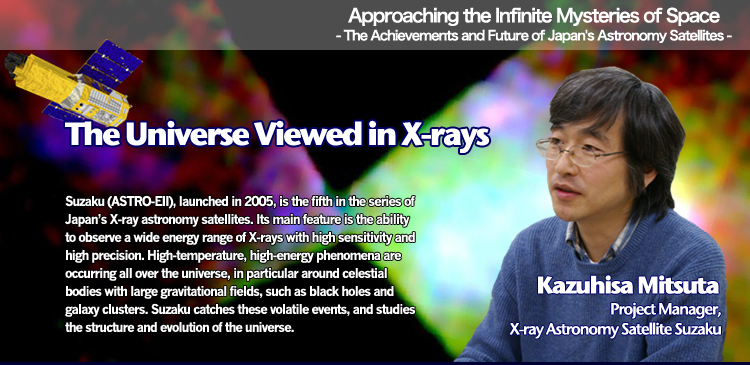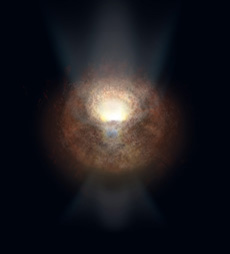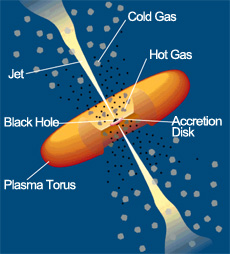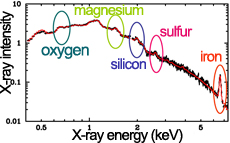
Q. What are the typical observation results obtained so far?
The main objectives of the Suzaku mission are to observe chigh-energy celestial phenomena that can help us understand the evolution of the universe. Let's look at the results obtained so far.

A galaxy with a bright center that emits radiation of various wavlengths is called an active galaxy. In the center of such an active galaxy - the activegalactic nucleus – there considered to exist a huge black hole with a mass that's millions, or even hundreds of millions of times that of the sun. (These are often called supermassive black holes.) When matter, i.e. gases and cosmic-dust particles fall into the black hole, they form an accretion disc around it.Observations by the X-ray astronomy satellite ASCA, launched in 1993, revealed that the accretion disc around a black hole emits peculiar X-rays. These X-rays are created by iron atoms (and are thus called iron emission lines), and their spectrum has the characteristic shape of a broad peak. Later, the European X-ray astronomy satellite XMM Newton has confirmed this result. Now, however, Suzaku can perform much more sophisticated observations. Its observation accuracy is much higher, because it can observe a wide energy-range of X-rays simultaneously, from high-energy hard X-rays with short wavelengths, to low-energy soft X-rays with long wavelengths. As a result, it can determine the shape of the underlying continuum emission more precisely, enabling us to determine the line shape, thus to capture the phenomena occurring near the black hole.
Suzaku observed the galaxy MCG-5-23-16, which is 120 million light-years away from us. Studying this data, we've became more certain that the X-ray emission peak broadens because of the strong gravitational field of the black hole.We think that the spectrum peak becomes even more broad, if the black hole itself is rotating rapidly. This is because when a black hole rotates, the space-time around the black hole is being dragged by it. If we can construct an even more precise observation instrument in the future, we may be able to see the space-time structure created around black holes in more detail. We believe that these huge black holes were created at the same time as the galaxies and stars, so the more we can learn about the black holes and their surroundings, the closer we can get to understanding how the universe evolved.

Artist's rendition of an active galactic core (Courtesy of NASA E/PO, Sonoma State University, Aurore Simonnet)

Artist's rendition of an accretion disc and the spectrum around the iron emission line from MCG-5-23-16, as captured by Suzaku. We think the broad X-ray peak is emitted from the accretion around the black hole, and the narrow X-ray peak is emitted from far away.


A new type of black hole

A black hole encircled by a torus (Courtesy of C.M. Urry and P. Padovani)
Generally, supermassive black holes inside active galactic nuclei are surrounded by a donut-shaped molecular cloud called a torus. Active galactic nuclei can appear to have various characteristics, such as brightness in visible light and in the X-ray spectrum, but it has been generally accepted that these differences in appearance were caused by the difference in the direction from which we observe the nucleus – for instance, whether we observe it through the torus or from above. However, Suzaku’s observations have given us data that could only be explained by the presence of a structure that isn’t a donut-shaped torus but encloses almost the entire black hole. In other words, we discovered a new type of black hole, which is covered by a large amount of matter. This suggests new possibilities. There may be many black holes like this in the universe, which we have not been able to see until now because the thick cloud of matter around them blocks photons at most of wavelengths. This black hole may be young, and as it evolves it may turn into a standard type of black hole surrounded by a torus.

The early universe, born 13.7 billion years ago, contained only hydrogen and helium. Other elements such as iron, oxygen and carbon are called heavy elements, and they are thought to have been created inside a star. The theory is that heavy elements were expelled from the star in the process of a supernova explosion, and dispersed into space. There is a celestial object called a galaxy cluster, which is formed when several hundred of galaxies gather together. Inside the galaxy cluster, the space between the galaxies is filled with high-temperature gas, heated to tens of million degrees due to the strong gravitational field of the galaxy cluster. This high-temperature gas also contains heavy elements. Previously, we’ve been able to observe clearly only a limited range of elements, from silicon to iron, but Suzaku can detect elements ranging from oxygen to iron individually simultaneous, with high sensitivity. This has allowed us to study the abundance pattern of heavy elements in this high temperature gas.
There are two representative types of supernova explosions: Type II, which involves heavy star, and Type Ia, in which a relatively light star explodes. A Type II supernova explosion creates mostly oxygen and magnesium, and a Type Ia supernova mainly creates iron. Suzaku’s observations have shown that Type II supernovae occur about three times more frequently than Type Ia supernovae. But at present, in the galaxy clusters, we hardly see a Type II supernova explosion. So it is possible that in the period of galaxy formation, many heavy stars were created and they exploded, leaving heavy elements.
In addition, Suzaku revealed that heavy elements are widely present even on the outer edges of the gravitational sphere of a galaxy cluster, 5 million light years from the center. The fact that heavy elements are spread so widely throughout space suggests that their creation and flowing out on into intergalactic space occurred about 10 billion years ago.


X-rays emitted from the gas of the AWM7 galaxy cluster. The bright region has a stronger X-ray intensity. The figure below shows the X-ray spectrum. At the marked positions are emission lines from heavy elements. (provided by: Kosuke Sato, Tokyo University of Science)